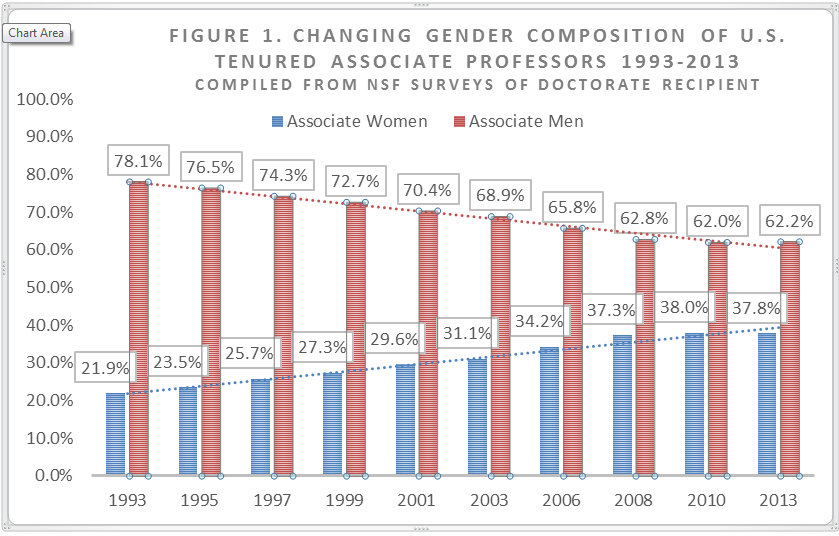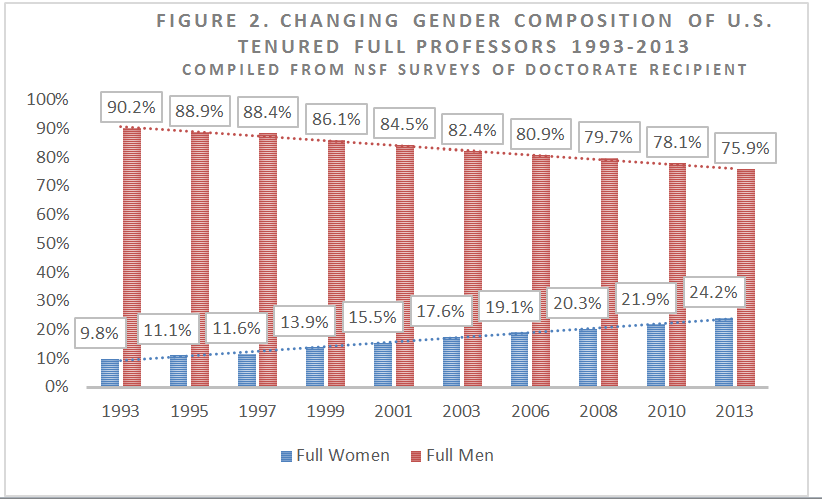You have /5 articles left.
Sign up for a free account or log in.
There are promising signs that some repairs are being made to the “leaky pipeline” for early-career women in academe. But to carry this increasingly contested metaphor one step farther, recent trends suggest the pipe is clogging farther up the line.
Faculty members who in earlier decades may have “leaked” out are now hitting an ivory ceiling as associate professors. In a previous piece, we discussed the major service demands unleashed upon earning tenure. Faculty who acquiesce to these requests by sacrificing their own research are penalized as terminal associates. This week we examine another interacting factor that explains why associate professors report the highest dissatisfaction levels among tenure-line faculty: work-family demands.
The composition of associate professors has diversified greatly over time. Gender composition is one major change. Figure 1 shows that over the last two decades, the proportion of women associate professors has almost doubled.
And Figure 2 shows that women as a percentage of full professors have almost tripled from 9.8 percent in 1993 to 24.2 percent in 2013 -- yet compared to the composition of doctorates in the cohorts that primarily compose full professors, women remain underrepresented.
This suggests there may be a clog in the pipeline. What explains the clog?
While faculty women continue to be less likely than men to have children, recent cohorts have seen substantial increases in faculty mothers. Given that faculty mothers tend to put off childbearing until later in life, many faculty members find themselves in the midst of intensive caregiving as associates, sometimes for aging parents and young children simultaneously.
It is increasingly true that fewer male faculty members have stay-at-home partners now than in the past, and many report feeling family-work balance stress. Even so, family responsibilities continue to weigh more heavily on academic mothers. For example, at our university 67 percent of partnered associate mothers reported being the primary caregiver for their children, compared to only 6 percent of associate fathers (54 percent reported being equal caregivers). When the posttenure service surge comes along, it threatens an already fragile work-family balance and makes the associate years especially fraught. The combination of increasing service expectations at work and care expectations at home can divert attention from research, which is the primary criterion for promotion in many universities.
In our research, we found that associate professors spent about 64 hours a week (including weekends) on work, slightly less than full professors. However, female associates spent more time than any other group on housework and care, almost 38 hours a week, totaling on average 102 paid and unpaid work hours each week (associate men spent almost 24 hours on housework and care for 90 hours each week total). This double whammy -- increasing workload as well as demands for housework and care -- make it easy to see why many associates are feeling the malaise creep in. As one faculty member we interviewed put it, “Associate professors are the ‘sandwich/panini’ generation. Many have young children and elderly parents. It’s hard to balance all of this and continue doing as much, if not more, work than ever.”
Unlike men, women sacrificed research time in order to meet their institutions’ high demands for teaching, mentoring and university service. While associate men reported spending substantially more of their work time (37 percent) on research than women (25 percent), women spent more time on teaching, mentoring and university service. Women who were mothers of small children were most likely to sacrifice their research time, while fathers of small children protected their research time. Women voiced frustration that they could not spend more time on their research. While excellent career advice abounds to “just say no,” the faculty we interviewed reported feeling responsible to their colleagues and students. One argued, “If I set limits, I know it means they will do that extra work. I feel guilty if I say no.”
The "Standing Still" report, research by Laura Perna and our own research on "The Ivory Ceiling of Service Work" document that women are particularly likely to get “stuck” as associates, and take longer to go up for promotion to full. By cohort, we found that women are less likely to be promoted than men and take longer to achieve promotions. At our institution, serving as undergraduate program director was associated with longer time to promotion for women (but not men). At many universities promotion to full comes with a substantial salary boost. Thus, the midcareer gully has direct economic ramifications that exacerbate existing gender pay gaps.
There are larger forces at play here, of course. The neoliberalizing university is increasingly outsourcing teaching to an exploited adjunct labor force and, in so doing, ramping up expectations for research productivity among tenure-line faculty as never before. With fewer full-time professors and fewer staff, the service burden among tenure-line faculty has risen inexorably at the same time. When we take into account these dramatic changes alongside the demographic shifts in the professoriate, it becomes clear that the resulting problems are most acute at the associate career stage.
How can we remedy this situation? In a previous column, we gave recommendations on rethinking the gendered service distribution at midcareer, along with policies to improve promotion practices. Here we argue that greater support for faculty members’ family responsibilities, including caring for elders, partners or children, will lead to better outcomes for faculty at all ranks, including midcareer faculty. Indeed, the American Council on Education is campaigning for college and university presidents to support faculty career flexibility, recognizing that doing so will lead to improved faculty well-being, recruitment and retention.
Offering family leave is perhaps one of the most important ways that a college or university can foster healthy work-family balance among its faculty. Our interviews with faculty parents who took a paid semester of family leave showed that this policy gave them invaluable time to care for a newborn while avoiding their careers being “blasted out of the water because of it.” Faculty without access to family-friendly policies are forced to make difficult choices. Reflecting on the death of her mother, which occurred prior to the adoption of the family leave policy at our university, a faculty member commented, ‘‘I was not able to balance work-family responsibilities and feel I neglected care of my mother in order to keep up with my teaching and service responsibilities. I regret it.’’
Although most universities offer some form of leave, in practice it is a six-week sick leave largely to be taken during pregnancy. Less than half of colleges and universities offer a full semester of paid leave to new mothers. Rarer still is gender-neutral parental leave. Some argue that paternity leave unfairly benefits men, however, our research shows that faculty fathers more often avoid using the policy, even when needed, for fear of stigma. We believe that encouraging caregiving fathers to utilize the policy will destigmatize leave-taking as women’s work and discourage an academic “mommy track.” At our university gender-neutral paid leave and modified duties are offered for all forms of family caregiving, and these policies are available to lecturers and tenure-line faculty members alike.
Child-care centers are another important means to enable faculty to juggle the demands of work and families. On-site child care has been shown to increase worker productivity, which would help remedy not just work-family balance issues but also narrow the gender gap in research time we have documented among associate professors.
Cultural change recognizing the need for such work-family balance policies is crucial. Faculty members should be made aware of and encouraged to use available work-life policies in order to promote a culture of use. Strong support from the administration in favor of balanced lives has important multiplying effects on campuses. Departmental chairs can set cultural standards by holding important meetings during school hours and scheduling teaching slots during school hours for parents of children. Part of changing the culture is also publicizing best practices. Administrators should publicly recognize departments with a good track record of benefit usage and supports.
Discussions about work-life balance in academe almost always focus on junior professors. But family care needs occur throughout the life course. Associate professors are often the forgotten “middle child” in tenure-line personnel concerns. Yet they experience intensive care demands in the midst of a suddenly escalated service workload. At the same time, they are encouraged to increase their pretenure research productivity levels while maintaining their teaching load in order to make promotion. It is no surprise that something has to give. Many choose the option that harms others the least and themselves the most. It’s a high price to pay.









